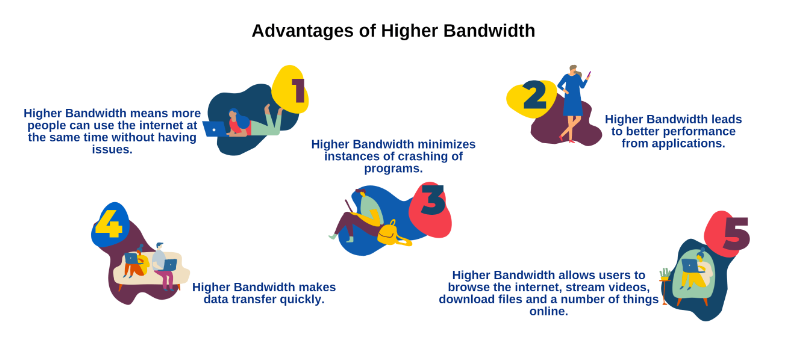If you’re reading this, you might be interested in learning more about bandwidth speed. You might be wondering exactly what it is, how important it could be, and what yours is. And that last part is especially important, given that you are paying your internet provider for services, and you should be getting those services. An ISP should be meeting the needs of its users. When it comes to things such as conferencing gaming, remote work needs, streaming, and so much more, are you getting the reliability and service you should be getting?
The good news is that you can test your bandwidth very easily. You just need to use a speed test along with perhaps a few other tools. However, what might be more important is that you have the contextual information and knowledge to make the most of the results. That way, you know if you have a problem, you will know what to do next. Everyone has goals for their bandwidth. Make sure that you can meet yours.
Here is everything you need to know about your bandwidth and how to test it easily.
What is Bandwidth?
Bandwidth, as a general rule, is a measurement of how much traffic a connection can handle at the same time. It is the maximum amount of data that can be transferred by or within the network. This is a slight differentiation from speed, which is the maximum speed data can be transported in the network. They might be the same depending on the equipment you are using, but they do not have to be. If you think of a network or connection as a highway, bandwidth is a combination of the speed limit and how many lanes it has.
Measuring Bandwidth
Bandwidth is measured in bits per second (bps), which is how many small data measurement units can be transmitted each second. However, given that we might be talking about millions of bits per second with faster connections, ISPs generally measure bandwidth in megabits per second or gigabits per second. We’ll provide some examples of how much bandwidth you need in these terms so that you will get a clearer picture shortly.
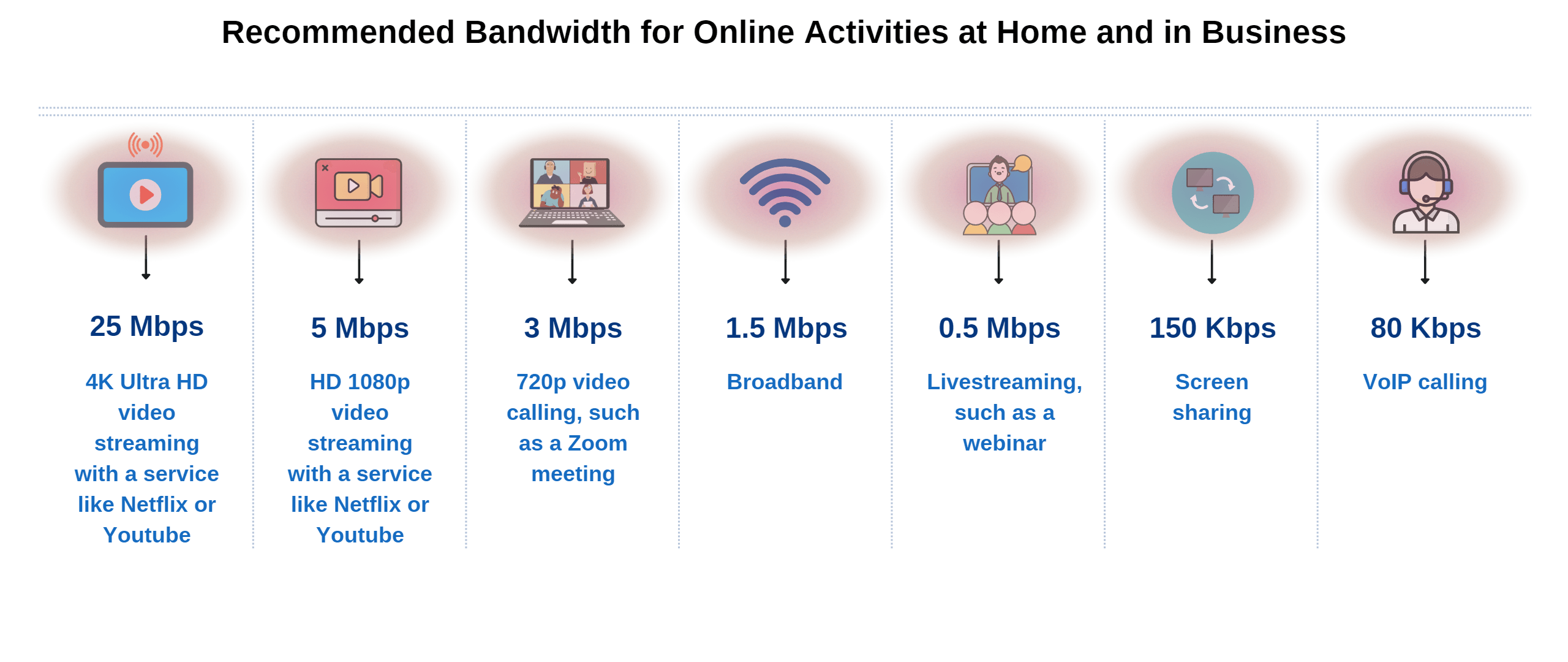
A common point of confusion and something we want to clear up now is the difference between Mbps (megabits per second) and MBps (megabytes per second). A byte is eight bits, so 1 MBps is eight times the rate of 1 Mbps. When using speed tests and most other tools, you will mostly be working with Mbps, so there is little to worry about.
While you might see some other terms used or different ways of talking about these terms, remember that these are the fundamentals you can return to.
Advantages of Higher Bandwidth
Everyone wants more bandwidth, and for good reason. There is no reason not to want more as it allows people to do more with their internet connections, and it usually leads to fewer connection issues and general problems with one’s internet service and what someone is trying to do online. With higher bandwidth, you can simply do more.
Here are some of the main advantages:
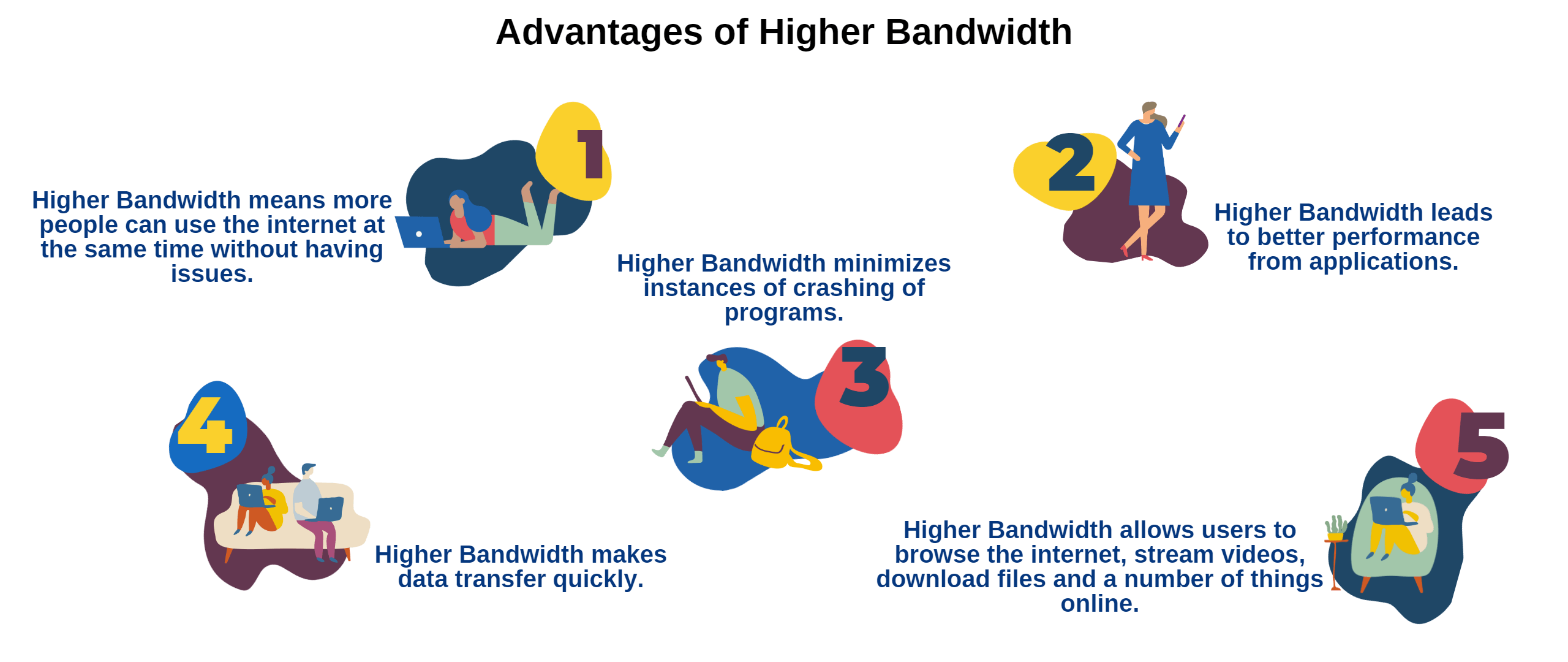
- More bandwidth means that more people can use the internet at the same time without there being issues. More specifically, it means more devices can connect to the internet and download and upload what they need to so that they can function as they should. Smart homes benefit a great deal from a higher bandwidth (or it allows them to be set up). And as another example, high bandwidth allows multiple people to stream what they want on their individual devices.
- It can often lead to better performance from applications. While processing power, RAM, and the specifications of your devices can determine how fast something might respond and get computed, there’s more to it than that. Applications need to download data regularly and sometimes constantly. Bandwidth makes that happen more easily, and you will notice the difference in some cases.
- It can reduce crashes of programs, dropped video calls, and errors relating to there simply not being enough bandwidth or a strong enough connection. While having more bandwidth will not solve every problem, and a high bandwidth connection can still have cutouts in service or inconsistencies, it can act as a buffer between those issues and a complete interruption for what you’re doing online.
- Data transfers will happen more quickly. Things can be easier if you need to send something to another device on your network. If you need to interact with the cloud, that will be easier.
- If you want to browse the internet, stream videos, download files, or do any number of things online, having more bandwidth allows you to do so faster. On top of that, you can stream things at a higher resolution or file quality (audiophiles will love being able to download the master tracks without fear of it taking forever). The internet will simply feel faster and more responsive, and you will hardly think about your internet connection itself. You’ll simply feel like you’re in the moment.
There’s more to having more bandwidth than the above, but these are the main benefits. If you use apps or programs that require a lot of bandwidth regularly, perhaps for work purposes, you’ll also notice a huge difference if you get a lot more bandwidth.
Evaluating Your Bandwidth Needs
All of the above is great in theory, but what do you need in practical terms? How much bandwidth does it take to stream Netflix or do any number of things? Everyone uses the internet a little bit differently and will need a different amount of bandwidth. However, you can get a general idea of how much bandwidth you need to fully enjoy some common online activities. Here are some guidelines to get you started:
- Online gaming doesn’t require as much bandwidth as you might need, 15-20 Mbps should be enough for most games, at least by themselves. If you have additional videos, streams, or voice chat going in the background, then adjust your needs accordingly. You will want at least 5 Mbps of upload speed as well. And finally, latency (or ping rate) might be the most important thing to your gaming experience once you clear the bar for bandwidth. Try to ensure that you have a latency below 50ms or at least below 90ms.
- Video streaming will vary based on the resolution being used. Standard resolution streaming doesn’t actually require much bandwidth, only 2 to 3 Mbps. High-definition streaming, defined at 720-1080p, requires somewhere between 3 and 8 Mbps, likely on the higher end of the scale with today’s media. And then there is 4K streaming, which will generally require 25 Mbps of bandwidth.
- We’ll mention it later, but we truly want to emphasize that these numbers are variable depending on the streaming service you are using.
- Music streaming does not take much bandwidth. If you’re constantly streaming music, you will need about 1-2 Mbps to keep up with it. However, you will want to increase that number if you use the higher-quality audio options available from music streaming services such as Apple Music and Tidal.
- Video calls and group conferencing can have quite the range for necessary bandwidth. You can likely get away with having 2 Mbps of bandwidth for a one-on-one video call (and don’t expect the best picture). HD video conferencing can require 6 Mbps or more, however. And then there’s telecommuting, which according to sources, can take anywhere from 5 to 25 Mbps of bandwidth.
- If you want to be truly safe when creating an online office and telecommuting setup, you should plan on having 10 Mbps download speed and 1 Mbps of upload speed bandwidth for every person on the call.
- Then there is general browsing, social media usage, and other activities people regularly use their phones and computers for. Someone can have 5 Mbps and take care of most of those things. However, the more bandwidth someone has at their disposal, the more seamless the experience will be, especially where video-focused social media is involved (and pictures are getting more detailed on social media).
- Smart home devices also require decent bandwidth to operate. The bandwidth needed varies by device, but a good rule of thumb is that unless otherwise stated, budget 1 Mbps of download speed for every smart device you have in your home. If there is video involved in the smart device, budget 5 Mbps of bandwidth instead.
Now it should be noted that the above listings are general recommendations, and the amount of bandwidth needed can change based on what service you’re using, what you might be streaming, and other factors. Additionally, just because you have exactly 15 Mbps of bandwidth doesn’t mean you’ll be able to do something that requires that much. Other processes and necessary downloads will be going on in the background. You will be able to minimize their effect through settings and careful usage, but you won’t be able to eliminate extra usage. It also means that if you plan on doing more than one thing at once, start adding up the bandwidth usage of the above.
That means we recommend having more bandwidth than the above says and simply having more bandwidth in general, if at all possible. It will allow you to do all the things above and more. However, you will likely need to change your plan or even provider to do so.
If you do not think you have the bandwidth you need or think you can do better (and you should check at the very least), we can help. Simply go to our internet comparison page to find the best ISP and company for you and your business.
How to Test Bandwidth Speeds
Testing your bandwidth has never been easier than it is now. You just need to know what speed you should have from your provider (if you want to compare), and you need to give yourself a few minutes.
This site includes an accurate speed test tool to help you determine your current connection's maximum speed. The test will automatically set up what it needs to, and you will get your results in a few seconds once it’s done measuring your speed. You will get results on your download speed, upload speed, ping, and jitter (more on these terms in a moment).
However, if you want to get the most accurate results possible or are planning on doing a series of tests, we recommend the following practices:
- Test your bandwidth under normal conditions. If you have a large download going or are streaming lots of content at the same time you are doing the test, it could interfere with the results.
- If you are testing your WiFi network, test in multiple areas of the home to ensure you have coverage and your bandwidth isn’t being bottlenecked by a problem with your network.
- If you are experiencing difficulties with internet speed on just one device, or think that might be the case, test using multiple devices (including the device in question).
- Try testing multiple times to make sure the results remain consistent if you have an extra minute. If you want to really test things over time, test your connection at different times of the day. Network congestion can affect bandwidth during peak hours, so it can be helpful to better understand its extent.
- Take notes once you get your results. You can take a screenshot of them as well. Just try to keep a record in case you notice a problem and need to talk to your ISP or technical support about things.
Understand Your Results
Some of the terms might be new to you if you haven’t tested your internet much before. You might be familiar with download speed, or that’s about it. Or maybe you might be unsure as to the exact definitions of things. Here are all the terms you’ll find on the Broadbandsearch speed test page, as well as their meaning:
Ping/Latency: The ping rate or latency of your connection is a measurement of how fast it takes a device to get a response after it sends out a request. Ping might be most relevant during video calls or when gaming online when “lag” can become a factor. It is measured in milliseconds (ms).
Network Jitter: A less commonly found metric, network jitter is the variation in latency on a packet flow between two systems. It happens when some packets take longer to travel from one system to another. It can result from network congestion, timing drift, and route changes. It is measured in milliseconds (ms).
Download Speed: Your download speed is a measurement of how quickly a device or connection can get data from an outside source. On a speed test, this can be the capacity of your connection. As a general rule, the higher your download speed, the faster you will be able to download files from the internet.
Upload Speed: In many ways, the same as download speed but in reverse, upload speed is a measurement of how quickly a device or connection can send data to an outside server or device.
Factors Affecting Bandwidth Performance
Bandwidth performance is affected by the following, though there may be additional lesser factors that could affect a network or connection:
- The first factor is the maximum capacity of a network connection. You will not be able to make a network that’s better than the broadband service you are getting, no matter how you set things up and what equipment you are using.
- The second factor to consider is the bottleneck of your network setup. Essentially, what is the lowest-bandwidth link in the chain when it comes to your network? There is your modem, your router, your broadband connection coming into your home, and the receivers on your various devices (though being endpoints, this rarely is an issue beyond a singular device). The lowest-bandwidth link is often referred to as the bottleneck and can slow down the entire network. Think of it like cars going on a highway, then having to go on a narrow one-way street before getting to their destination.
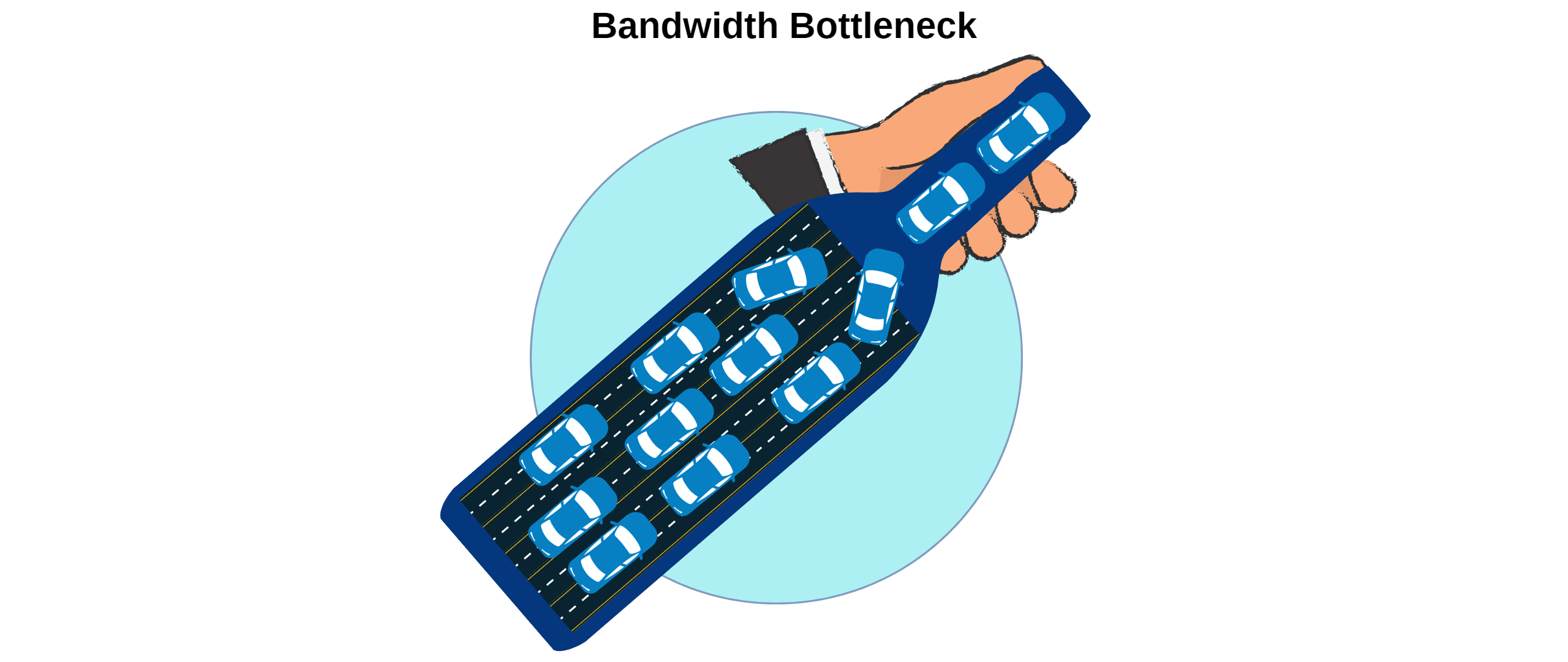
- The third factor you should be looking for is bandwidth throttling by your ISP. This is when an internet provider slows down your internet speed deliberately. There are legitimate reasons that an ISP can throttle a connection, such as a user going over the data cap or there being an overall issue in the network leading to heavy congestion. There are also few to no legitimate ways to get around throttling outside of understanding why they did it in the first place and responding to that.
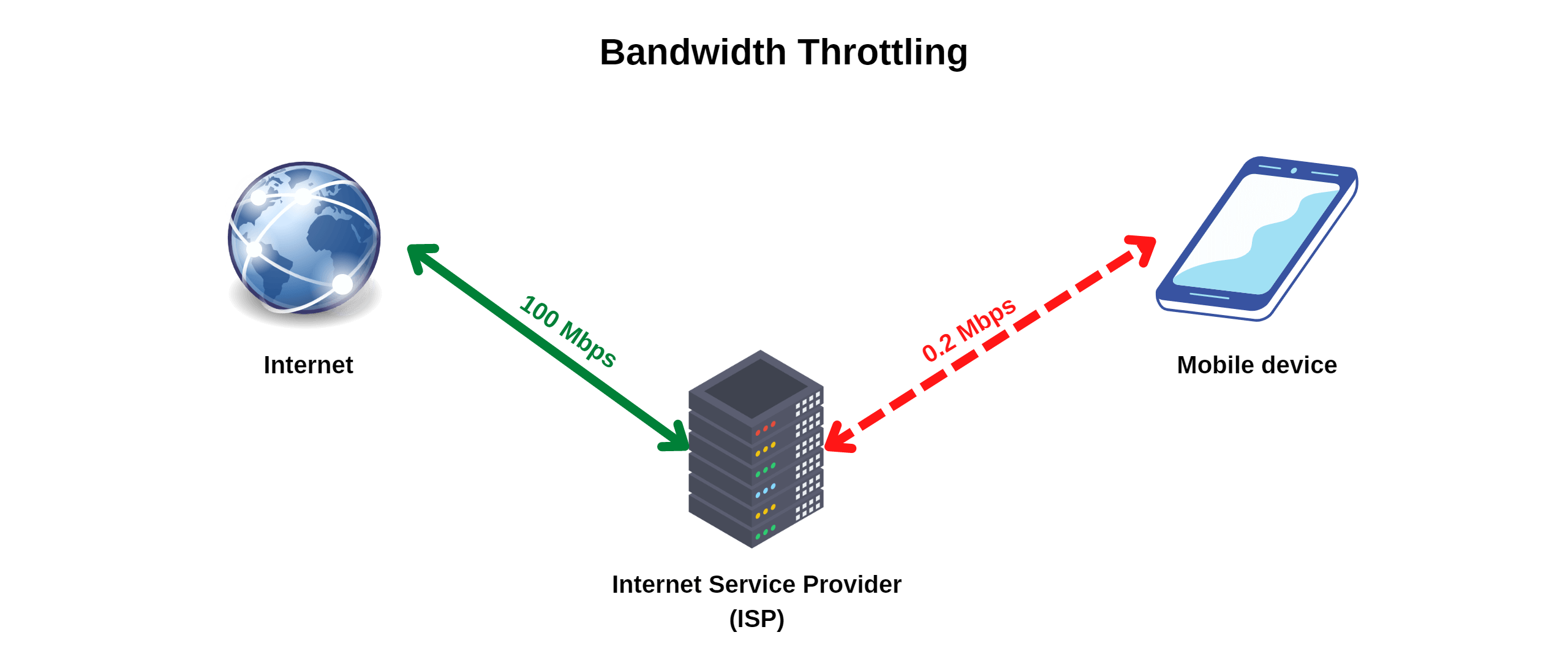
Conclusion
Both knowing your bandwidth and the ways you can make it work better for you are important things worth your attention and worth further reading. Yet the key takeaway here is that testing your bandwidth is the key step. It allows you to know whether you are getting the service you paid for and whether your service will be enough for your plans.
We hope that you have a better idea of what you are looking for and that you will be able to use this information to improve your connection. Thank you for reading, and please return to this page or our speed test page as you feel the need.
FAQ
How many devices can my internet connection handle?
Two limiting factors can come into play. The first is your bandwidth and the general download and upload speed you are working with. If you try and download too much over all your devices, you will only run into problems.
The second is the number of devices that your router or modem can handle. While it appears as though they can handle as many devices as you can throw at them, especially the newer routers, there is an upper limit. You can usually find it alongside router information and by looking online about your model.
How to check my WiFi bandwidth?
To check your bandwidth, you can use a speed test. Note that depending on your device, you might not get your bandwidth but your device's speed. Make sure that you don’t have too many processes running in the background. That will give you an accurate reading of your WiFi bandwidth and will let you know if you need to fix something.
What happens after you exceed data cap limits?
It will depend on the service provider you are working with. What usually happens is one of a few things. First, your connection will be throttled, and you’ll be dealing with much slower internet speeds until the next month. You may get charged heavily for additional data usage, sometimes by 100GB or sometimes for much less usage. And finally, you could get reminded to upgrade your service somehow, alongside throttling or extra charges.
We recommend keeping an eye on your data usage if you download many things or have a low data cap.
What device has the fastest bandwidth speed?
It will vary, and it will depend on both your device and bandwidth speed. If you look at the fastest router or modem, new ones are coming out yearly to top the previous model. Any answer we could offer would possibly be outdated in a matter of weeks.
Yet no matter how you look at it, the answer will keep changing, and this question warrants additional research on your part. If you find yourself asking this, you might want to redefine the question in terms of what you are looking for or whether you are looking for bandwidth speed, or something else. In truth, if you want more bandwidth speed, you should look at your provider first. That will be the limiting factor.
How would a VPN increase bandwidth speed?
In nearly all cases, it wouldn’t. While a VPN doesn’t necessarily lower your bandwidth, it can take some bandwidth to use. Additionally, people might experience a slower connection due to higher latency. A VPN needs to reroute traffic through an additional node while wrapped up in encryption. This means requests and information take longer, depending on the VPN server used and other factors. Some VPNs are faster than others, but you shouldn’t expect them to increase your bandwidth speed.

